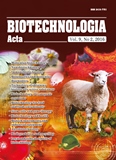ISSN 2410-7751 (Print)
ISSN 2410-776X (on-line)

Ж-л "Biotechnologia Acta" Т. 9, № 2, 2016
https://doi.org/10.15407/biotech9.02.055
P. 55-60-, Bibliography.26, English.
УДК: 602.64
TARRAGON (Artemisia dracunculus L.) “HAIRY” ROOT CULTURE PRODUCTION
K. O. Drobot, А. М. Shakhovsky, N. A. Matvieieva
Institute of Cell Biology and Genetic Engineering of the National Academy of Sciences of Ukraine, Kyiv
This paper is devoted the biotechnology development of Artemisia dracunculus L. genetic transformation. We obtained the transgenic A. dracunculus “hairy” root culture using A. rhizogenes A4-mediated transformation. The conditions of tarragon’s genetic transformation were optimized. It was shown that leaves of in vitro cultivated plants were the optimal type of explants. The transgenic root formation frequency was up to 20% in case of leaves usage. The time of explants cocultivation with Agrobacterium suspension was found to be an important factor of biotechnology which affects the frequency of transgenic root growth. Transgenic root lines differed in morphological features and growth rate. Specific mass increase varied from 17 to 32 times after 3 weeks cultivation on 1/2 Murashige-Skoog medium.
Key words: Artemisia dracunculus L., genetic transformation, Agrobacterium rhizogenes А4, “hairy” root culture.
© Palladin Institute of Biochemistry of National Academy of Sciences of Ukraine, 2016
References
1. Bora K. S., Sharma A. The genus Artemisia: A comprehensive review. Pharm. Biol. 2011, V. 49, P. 101–109.
2. Boiko A. V. Specific features of Artemisia L. species distribution of the flora of Ukraine. Indust. Botany. 2013, V. 13, P. 73?79.
3. Abad M. J., Bedoya L. M., Apaza L., Bermejo P. The Artemisia L. Genus: a review of bioactive essential oils. Molecules. 2012, 17 (3), 2542?2566.
4. Sutton S., Humphries C., Hopkinson J. Tarragon. Garden UK. British Museum (Natural History), South Kensington, London, UK. 1985, 110 (5), 237?240.
5. Uhl S. R., Strauss S. Handbook of Spices, Seasonings and Flavorings. Lancaster: Technomic Publishing. 2000, 330 p.
6. Eidi A., Oryan S., Zaringhalam J., Rad M. Antinociceptive and anti-inflammatory effects of the aerial parts of Artemisia dracunculus in mice. Pharm Biol. 2016, 54 (3), 549?554.
7. Aglarova A. M. Comparative Analysis of Secondary Metabolites of Artemisia dracunculus L., Russian and French cultivars (Doctoral dissertation). Available from ProQuest Dissertations & Theses database. 2006. (UMI No. 327681).
8. Mohsenzadeh M. Evaluation of antibacterial activity of selected Iranian essential oils against Staphylococcus aureus and Escherichia coli in nutrient broth medium. Pak. J. Bio.l Sci. 2007, 10 (20), 3693?3697.
9. O'Mahony R., Al-Khtheeri H., Weerasekera D., Fernando N., Vaira D., Holton J., Basset C. Bactericidal and anti-adhesive properties of culinary and medicinal plants against Helicobacter pylori. World J. Gastroenterol. 2005, 11 (47), 7499?7507.
10. Mannan A., Ahmed I., Arshad W., Asim M. F., Qureshi R. A., Hussain I. Survey of artemisinin production by diverse Artemisia species in northern Pakistan. Malar J. 2010, V. 9, P. 310.
11. Fern?ndez-Lizarazo J., Mosquera-V?squez T. Efficient micropropagation of french tarragon (Artemisia dracunculus L.). Agronomia colombiana. 2012, 30 (3), 335?343.
12. Obolskiy D., Pischel I., Feistel B., Glotov N., Heinrich M. Artemisia dracunculus L. (Tarragon): A critical review of its traditional use, chemical composition, pharmacology and safety. J. Agric. Food Chem. 2011, 59, 11367–11384.
13. Srivastava S., Srivastava A. K. Hairy root culture for massproduction of high-value secondary metabolites. Crit. Rev. Biotechnol. 2007, V. 27, P. 29–43.
14. Christey M. C. Use of Ri-mediated transformation for production of transgenic plants. In Vitro Cell Dev. Biol. Plant. 2001, V. 37, P. 687–700.
15. Kim Y. J., Weathers P. J., Wyslouzil B. E. The growth of Artemisia annua hairy roots in liquid and gas phase reactors. Biotechnol. Bioeng. 2002, V. 80, P. 454–464.
16. Giri A. Narasu M. L. Transgenic hairy roots: recent trends and applications. Biotechnol. Adv. 2000, 18 (1), 22.
17. Weathers P. J., Bunk G., McCoy M. C. The effect of phytohormones on growth and artemisinin production in Artemisia annua hairy roots. In Vitro Cell Dev. Biol. Plant. 2005, 41 (1), 47–53.
18. Ahlawat S., Saxena P., Ram M., Pravej A., Tazyeen N., Anis M., Malik Z. A. Influence of Agrobacterium rhizogenes on induction of hairy roots for enhanced production of artemisinin in Artemisia annua L. Plants. Afr. J. Biotechnol. 2012, 11 (35), 8684–8691.
19. Mannan A., Shaheen N., Arshad W., Qureshi R. A., Muhammad Z., Bushra M. Hairy roots induction and artemisinin analysis in Artemisia dubia and Artemisia indica. Afr. J. Biotechnol. 2008, 7 (18), 3288–3292.
20. Sharafi A., Sohi H. H., Mirzaee H., Azadi P. In vitro regeneration and Agrobacterium mediated genetic transformation of Artemisia aucheri Boiss. Physiol. Mol. Biol. Plants. 2014, 20 (4), 487–494.
21. Sujatha G., Zdravkovic-Korac S., Calic D., Flamin G., Ranjitha Kumari B. D. Highefficiency Agrobacterium rhizogenes mediated genetic Transformation in Artemisia vulgaris: Hairy root production and Essential oil analysis. Industr. Crops Prod. 2013, V. 44, P. 643–652.
22. Nin S., Bennici G., Roselli D., Mariotti D., Schiff S., Magherini R. Agrobacterium mediated transformation of Artemisia absinthium L. (wormwood) and production of secondary metabolites. Plant Cell Rep. 1997, 16 (10), 725–730.
23. Murashige T., Skoog F. A revised medium for rapid growth and bioassay with tobacco tissue culture. Phys. Plant. 1962, 15 (3), 473–497.
24. Van-de-Velde W., Karimi M., Den-Herder G., Van-Montagu M., Holsters M., Goormachtig S. Agrobacterium rhizogenes-mediated transformation of plants. Genetic Transformation of Plants (Molecular Methods of Plant Analysis). Jackson J. F., Linskens H. F. (Eds.). Springer-Verlag Berlin. 2003, P. 221?229.
25. Drobot K. O., Shakhovsky A. M., Matvieieva N. A. Construction of Artemisia vulgaris l. “hairy” root culture with human interferon alpha 2b gene. Factors in Experimental Evolution of Organisms: Proceedings of the Tenth International Conference. Chernivtsi: Yuriy Fedkovych Chernivtsi National University, 2015.
26. Schmulling T., Schell J., Spena A. Single genes from Agrobacterium rhizogenes influence plant development. The EMBO J. 1988, 7 (9), 2621–2629.

